ACC8801: Corporate Governance and Social Responsibility - James Hardie
VerifiedAdded on 2019/09/22
|11
|2409
|401
Homework Assignment
AI Summary
This assignment analyzes the James Hardie case, a significant example of corporate governance failures and social irresponsibility. The assignment addresses six short answer questions focusing on the company's actions related to asbestos production and its impact on various stakeholders. It examines the corporate governance responsibilities of James Hardie's board and senior management, identifying key corporate governance issues in relation to ASX principles, and explores actions the company could have taken to comply with these guidelines. The assignment delves into how the long-term interests of stakeholders were affected by the company's decisions, the ethical and legal implications of these decisions, and how the actions of various stakeholders threatened the company's sustainability. The analysis covers topics such as stakeholder analysis, ethical decision-making, the role of the MRCF, and the company's restructuring efforts to avoid liabilities. The assignment aims to assess students' understanding of corporate governance, ethical obligations, and social responsibility issues in business decision-making, as well as their ability to apply regulatory requirements and utilize critical ethical and social thinking skills.
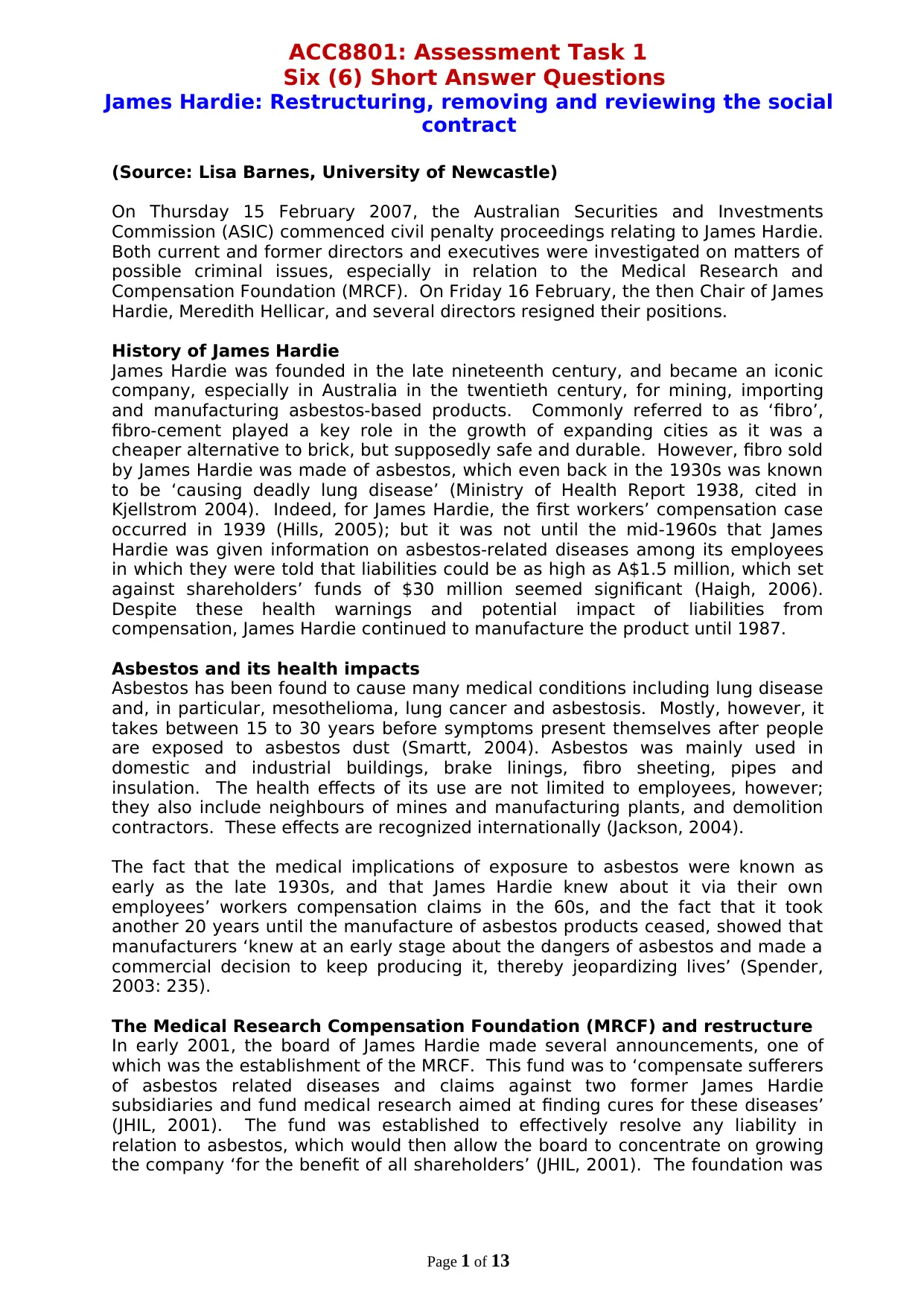
ACC8801: Assessment Task 1
Six (6) Short Answer Questions
James Hardie: Restructuring, removing and reviewing the social
contract
(Source: Lisa Barnes, University of Newcastle)
On Thursday 15 February 2007, the Australian Securities and Investments
Commission (ASIC) commenced civil penalty proceedings relating to James Hardie.
Both current and former directors and executives were investigated on matters of
possible criminal issues, especially in relation to the Medical Research and
Compensation Foundation (MRCF). On Friday 16 February, the then Chair of James
Hardie, Meredith Hellicar, and several directors resigned their positions.
History of James Hardie
James Hardie was founded in the late nineteenth century, and became an iconic
company, especially in Australia in the twentieth century, for mining, importing
and manufacturing asbestos-based products. Commonly referred to as ‘fibro’,
fibro-cement played a key role in the growth of expanding cities as it was a
cheaper alternative to brick, but supposedly safe and durable. However, fibro sold
by James Hardie was made of asbestos, which even back in the 1930s was known
to be ‘causing deadly lung disease’ (Ministry of Health Report 1938, cited in
Kjellstrom 2004). Indeed, for James Hardie, the first workers’ compensation case
occurred in 1939 (Hills, 2005); but it was not until the mid-1960s that James
Hardie was given information on asbestos-related diseases among its employees
in which they were told that liabilities could be as high as A$1.5 million, which set
against shareholders’ funds of $30 million seemed significant (Haigh, 2006).
Despite these health warnings and potential impact of liabilities from
compensation, James Hardie continued to manufacture the product until 1987.
Asbestos and its health impacts
Asbestos has been found to cause many medical conditions including lung disease
and, in particular, mesothelioma, lung cancer and asbestosis. Mostly, however, it
takes between 15 to 30 years before symptoms present themselves after people
are exposed to asbestos dust (Smartt, 2004). Asbestos was mainly used in
domestic and industrial buildings, brake linings, fibro sheeting, pipes and
insulation. The health effects of its use are not limited to employees, however;
they also include neighbours of mines and manufacturing plants, and demolition
contractors. These effects are recognized internationally (Jackson, 2004).
The fact that the medical implications of exposure to asbestos were known as
early as the late 1930s, and that James Hardie knew about it via their own
employees’ workers compensation claims in the 60s, and the fact that it took
another 20 years until the manufacture of asbestos products ceased, showed that
manufacturers ‘knew at an early stage about the dangers of asbestos and made a
commercial decision to keep producing it, thereby jeopardizing lives’ (Spender,
2003: 235).
The Medical Research Compensation Foundation (MRCF) and restructure
In early 2001, the board of James Hardie made several announcements, one of
which was the establishment of the MRCF. This fund was to ‘compensate sufferers
of asbestos related diseases and claims against two former James Hardie
subsidiaries and fund medical research aimed at finding cures for these diseases’
(JHIL, 2001). The fund was established to effectively resolve any liability in
relation to asbestos, which would then allow the board to concentrate on growing
the company ‘for the benefit of all shareholders’ (JHIL, 2001). The foundation was
Page 1 of 13
Six (6) Short Answer Questions
James Hardie: Restructuring, removing and reviewing the social
contract
(Source: Lisa Barnes, University of Newcastle)
On Thursday 15 February 2007, the Australian Securities and Investments
Commission (ASIC) commenced civil penalty proceedings relating to James Hardie.
Both current and former directors and executives were investigated on matters of
possible criminal issues, especially in relation to the Medical Research and
Compensation Foundation (MRCF). On Friday 16 February, the then Chair of James
Hardie, Meredith Hellicar, and several directors resigned their positions.
History of James Hardie
James Hardie was founded in the late nineteenth century, and became an iconic
company, especially in Australia in the twentieth century, for mining, importing
and manufacturing asbestos-based products. Commonly referred to as ‘fibro’,
fibro-cement played a key role in the growth of expanding cities as it was a
cheaper alternative to brick, but supposedly safe and durable. However, fibro sold
by James Hardie was made of asbestos, which even back in the 1930s was known
to be ‘causing deadly lung disease’ (Ministry of Health Report 1938, cited in
Kjellstrom 2004). Indeed, for James Hardie, the first workers’ compensation case
occurred in 1939 (Hills, 2005); but it was not until the mid-1960s that James
Hardie was given information on asbestos-related diseases among its employees
in which they were told that liabilities could be as high as A$1.5 million, which set
against shareholders’ funds of $30 million seemed significant (Haigh, 2006).
Despite these health warnings and potential impact of liabilities from
compensation, James Hardie continued to manufacture the product until 1987.
Asbestos and its health impacts
Asbestos has been found to cause many medical conditions including lung disease
and, in particular, mesothelioma, lung cancer and asbestosis. Mostly, however, it
takes between 15 to 30 years before symptoms present themselves after people
are exposed to asbestos dust (Smartt, 2004). Asbestos was mainly used in
domestic and industrial buildings, brake linings, fibro sheeting, pipes and
insulation. The health effects of its use are not limited to employees, however;
they also include neighbours of mines and manufacturing plants, and demolition
contractors. These effects are recognized internationally (Jackson, 2004).
The fact that the medical implications of exposure to asbestos were known as
early as the late 1930s, and that James Hardie knew about it via their own
employees’ workers compensation claims in the 60s, and the fact that it took
another 20 years until the manufacture of asbestos products ceased, showed that
manufacturers ‘knew at an early stage about the dangers of asbestos and made a
commercial decision to keep producing it, thereby jeopardizing lives’ (Spender,
2003: 235).
The Medical Research Compensation Foundation (MRCF) and restructure
In early 2001, the board of James Hardie made several announcements, one of
which was the establishment of the MRCF. This fund was to ‘compensate sufferers
of asbestos related diseases and claims against two former James Hardie
subsidiaries and fund medical research aimed at finding cures for these diseases’
(JHIL, 2001). The fund was established to effectively resolve any liability in
relation to asbestos, which would then allow the board to concentrate on growing
the company ‘for the benefit of all shareholders’ (JHIL, 2001). The foundation was
Page 1 of 13
Paraphrase This Document
Need a fresh take? Get an instant paraphrase of this document with our AI Paraphraser
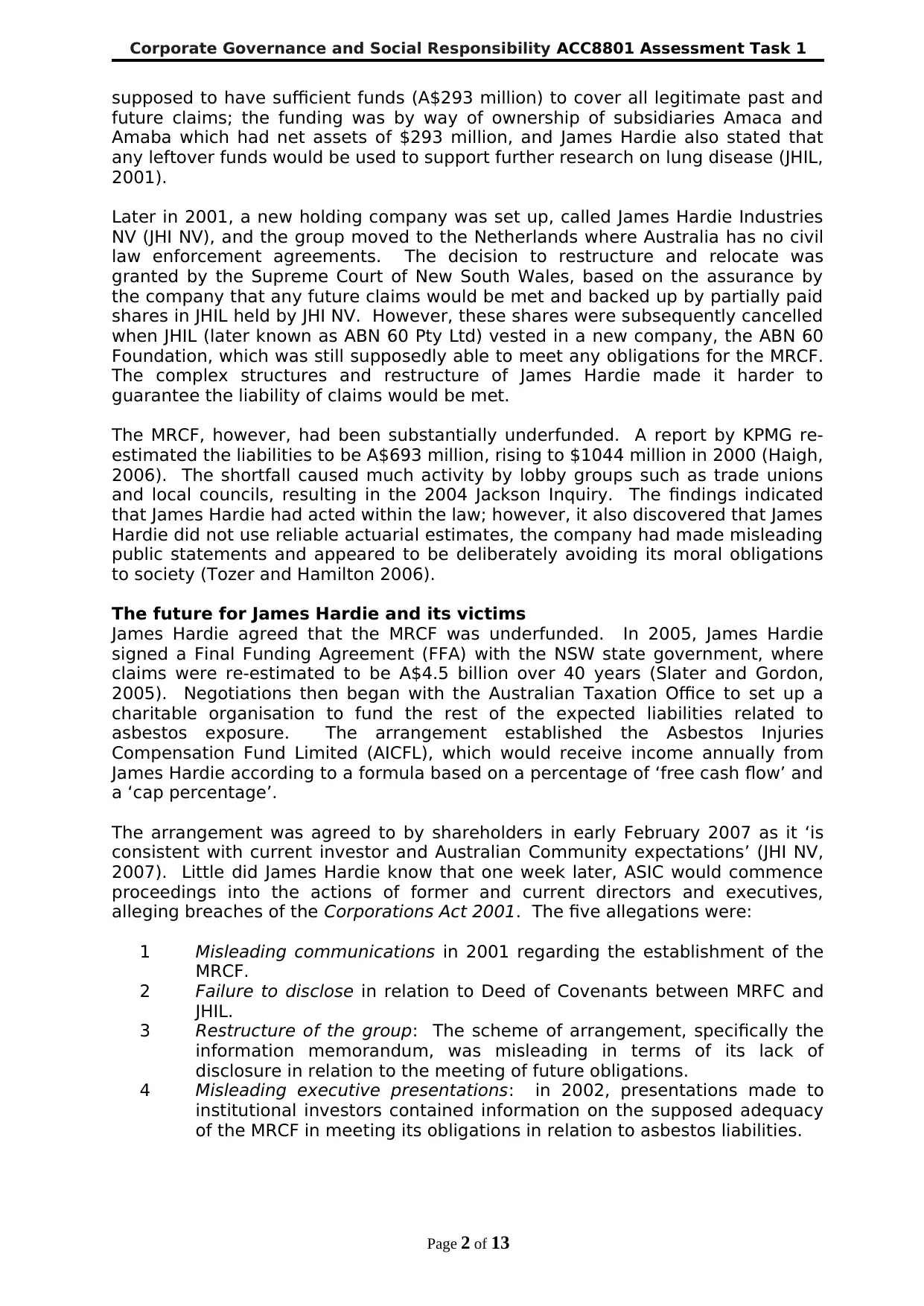
Corporate Governance and Social Responsibility ACC8801 Assessment Task 1
supposed to have sufficient funds (A$293 million) to cover all legitimate past and
future claims; the funding was by way of ownership of subsidiaries Amaca and
Amaba which had net assets of $293 million, and James Hardie also stated that
any leftover funds would be used to support further research on lung disease (JHIL,
2001).
Later in 2001, a new holding company was set up, called James Hardie Industries
NV (JHI NV), and the group moved to the Netherlands where Australia has no civil
law enforcement agreements. The decision to restructure and relocate was
granted by the Supreme Court of New South Wales, based on the assurance by
the company that any future claims would be met and backed up by partially paid
shares in JHIL held by JHI NV. However, these shares were subsequently cancelled
when JHIL (later known as ABN 60 Pty Ltd) vested in a new company, the ABN 60
Foundation, which was still supposedly able to meet any obligations for the MRCF.
The complex structures and restructure of James Hardie made it harder to
guarantee the liability of claims would be met.
The MRCF, however, had been substantially underfunded. A report by KPMG re-
estimated the liabilities to be A$693 million, rising to $1044 million in 2000 (Haigh,
2006). The shortfall caused much activity by lobby groups such as trade unions
and local councils, resulting in the 2004 Jackson Inquiry. The findings indicated
that James Hardie had acted within the law; however, it also discovered that James
Hardie did not use reliable actuarial estimates, the company had made misleading
public statements and appeared to be deliberately avoiding its moral obligations
to society (Tozer and Hamilton 2006).
The future for James Hardie and its victims
James Hardie agreed that the MRCF was underfunded. In 2005, James Hardie
signed a Final Funding Agreement (FFA) with the NSW state government, where
claims were re-estimated to be A$4.5 billion over 40 years (Slater and Gordon,
2005). Negotiations then began with the Australian Taxation Office to set up a
charitable organisation to fund the rest of the expected liabilities related to
asbestos exposure. The arrangement established the Asbestos Injuries
Compensation Fund Limited (AICFL), which would receive income annually from
James Hardie according to a formula based on a percentage of ‘free cash flow’ and
a ‘cap percentage’.
The arrangement was agreed to by shareholders in early February 2007 as it ‘is
consistent with current investor and Australian Community expectations’ (JHI NV,
2007). Little did James Hardie know that one week later, ASIC would commence
proceedings into the actions of former and current directors and executives,
alleging breaches of the Corporations Act 2001. The five allegations were:
1 Misleading communications in 2001 regarding the establishment of the
MRCF.
2 Failure to disclose in relation to Deed of Covenants between MRFC and
JHIL.
3 Restructure of the group: The scheme of arrangement, specifically the
information memorandum, was misleading in terms of its lack of
disclosure in relation to the meeting of future obligations.
4 Misleading executive presentations: in 2002, presentations made to
institutional investors contained information on the supposed adequacy
of the MRCF in meeting its obligations in relation to asbestos liabilities.
Page 2 of 13
supposed to have sufficient funds (A$293 million) to cover all legitimate past and
future claims; the funding was by way of ownership of subsidiaries Amaca and
Amaba which had net assets of $293 million, and James Hardie also stated that
any leftover funds would be used to support further research on lung disease (JHIL,
2001).
Later in 2001, a new holding company was set up, called James Hardie Industries
NV (JHI NV), and the group moved to the Netherlands where Australia has no civil
law enforcement agreements. The decision to restructure and relocate was
granted by the Supreme Court of New South Wales, based on the assurance by
the company that any future claims would be met and backed up by partially paid
shares in JHIL held by JHI NV. However, these shares were subsequently cancelled
when JHIL (later known as ABN 60 Pty Ltd) vested in a new company, the ABN 60
Foundation, which was still supposedly able to meet any obligations for the MRCF.
The complex structures and restructure of James Hardie made it harder to
guarantee the liability of claims would be met.
The MRCF, however, had been substantially underfunded. A report by KPMG re-
estimated the liabilities to be A$693 million, rising to $1044 million in 2000 (Haigh,
2006). The shortfall caused much activity by lobby groups such as trade unions
and local councils, resulting in the 2004 Jackson Inquiry. The findings indicated
that James Hardie had acted within the law; however, it also discovered that James
Hardie did not use reliable actuarial estimates, the company had made misleading
public statements and appeared to be deliberately avoiding its moral obligations
to society (Tozer and Hamilton 2006).
The future for James Hardie and its victims
James Hardie agreed that the MRCF was underfunded. In 2005, James Hardie
signed a Final Funding Agreement (FFA) with the NSW state government, where
claims were re-estimated to be A$4.5 billion over 40 years (Slater and Gordon,
2005). Negotiations then began with the Australian Taxation Office to set up a
charitable organisation to fund the rest of the expected liabilities related to
asbestos exposure. The arrangement established the Asbestos Injuries
Compensation Fund Limited (AICFL), which would receive income annually from
James Hardie according to a formula based on a percentage of ‘free cash flow’ and
a ‘cap percentage’.
The arrangement was agreed to by shareholders in early February 2007 as it ‘is
consistent with current investor and Australian Community expectations’ (JHI NV,
2007). Little did James Hardie know that one week later, ASIC would commence
proceedings into the actions of former and current directors and executives,
alleging breaches of the Corporations Act 2001. The five allegations were:
1 Misleading communications in 2001 regarding the establishment of the
MRCF.
2 Failure to disclose in relation to Deed of Covenants between MRFC and
JHIL.
3 Restructure of the group: The scheme of arrangement, specifically the
information memorandum, was misleading in terms of its lack of
disclosure in relation to the meeting of future obligations.
4 Misleading executive presentations: in 2002, presentations made to
institutional investors contained information on the supposed adequacy
of the MRCF in meeting its obligations in relation to asbestos liabilities.
Page 2 of 13
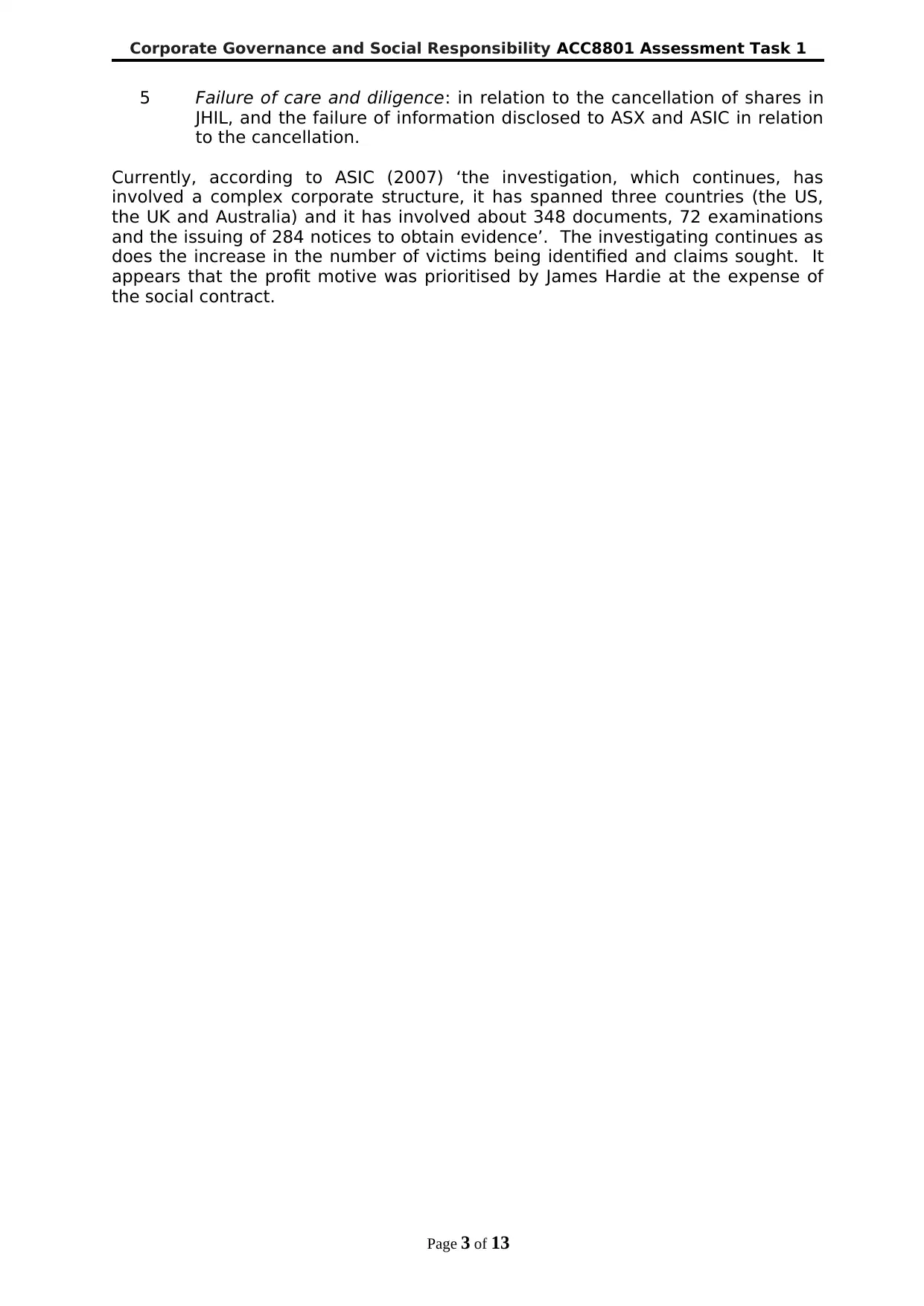
Corporate Governance and Social Responsibility ACC8801 Assessment Task 1
5 Failure of care and diligence: in relation to the cancellation of shares in
JHIL, and the failure of information disclosed to ASX and ASIC in relation
to the cancellation.
Currently, according to ASIC (2007) ‘the investigation, which continues, has
involved a complex corporate structure, it has spanned three countries (the US,
the UK and Australia) and it has involved about 348 documents, 72 examinations
and the issuing of 284 notices to obtain evidence’. The investigating continues as
does the increase in the number of victims being identified and claims sought. It
appears that the profit motive was prioritised by James Hardie at the expense of
the social contract.
Page 3 of 13
5 Failure of care and diligence: in relation to the cancellation of shares in
JHIL, and the failure of information disclosed to ASX and ASIC in relation
to the cancellation.
Currently, according to ASIC (2007) ‘the investigation, which continues, has
involved a complex corporate structure, it has spanned three countries (the US,
the UK and Australia) and it has involved about 348 documents, 72 examinations
and the issuing of 284 notices to obtain evidence’. The investigating continues as
does the increase in the number of victims being identified and claims sought. It
appears that the profit motive was prioritised by James Hardie at the expense of
the social contract.
Page 3 of 13
⊘ This is a preview!⊘
Do you want full access?
Subscribe today to unlock all pages.

Trusted by 1+ million students worldwide
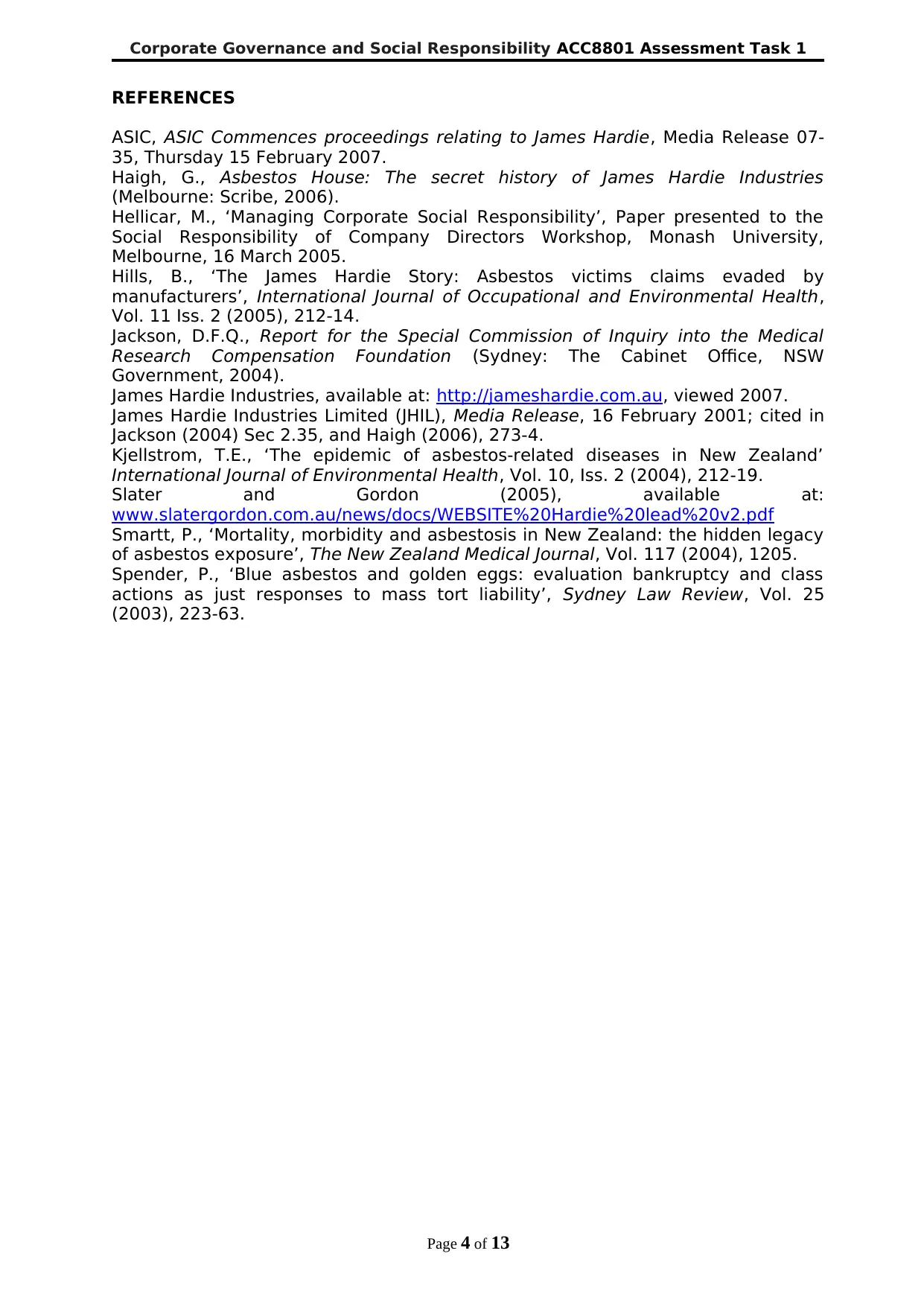
Corporate Governance and Social Responsibility ACC8801 Assessment Task 1
REFERENCES
ASIC, ASIC Commences proceedings relating to James Hardie, Media Release 07-
35, Thursday 15 February 2007.
Haigh, G., Asbestos House: The secret history of James Hardie Industries
(Melbourne: Scribe, 2006).
Hellicar, M., ‘Managing Corporate Social Responsibility’, Paper presented to the
Social Responsibility of Company Directors Workshop, Monash University,
Melbourne, 16 March 2005.
Hills, B., ‘The James Hardie Story: Asbestos victims claims evaded by
manufacturers’, International Journal of Occupational and Environmental Health,
Vol. 11 Iss. 2 (2005), 212-14.
Jackson, D.F.Q., Report for the Special Commission of Inquiry into the Medical
Research Compensation Foundation (Sydney: The Cabinet Office, NSW
Government, 2004).
James Hardie Industries, available at: http://jameshardie.com.au, viewed 2007.
James Hardie Industries Limited (JHIL), Media Release, 16 February 2001; cited in
Jackson (2004) Sec 2.35, and Haigh (2006), 273-4.
Kjellstrom, T.E., ‘The epidemic of asbestos-related diseases in New Zealand’
International Journal of Environmental Health, Vol. 10, Iss. 2 (2004), 212-19.
Slater and Gordon (2005), available at:
www.slatergordon.com.au/news/docs/WEBSITE%20Hardie%20lead%20v2.pdf
Smartt, P., ‘Mortality, morbidity and asbestosis in New Zealand: the hidden legacy
of asbestos exposure’, The New Zealand Medical Journal, Vol. 117 (2004), 1205.
Spender, P., ‘Blue asbestos and golden eggs: evaluation bankruptcy and class
actions as just responses to mass tort liability’, Sydney Law Review, Vol. 25
(2003), 223-63.
Page 4 of 13
REFERENCES
ASIC, ASIC Commences proceedings relating to James Hardie, Media Release 07-
35, Thursday 15 February 2007.
Haigh, G., Asbestos House: The secret history of James Hardie Industries
(Melbourne: Scribe, 2006).
Hellicar, M., ‘Managing Corporate Social Responsibility’, Paper presented to the
Social Responsibility of Company Directors Workshop, Monash University,
Melbourne, 16 March 2005.
Hills, B., ‘The James Hardie Story: Asbestos victims claims evaded by
manufacturers’, International Journal of Occupational and Environmental Health,
Vol. 11 Iss. 2 (2005), 212-14.
Jackson, D.F.Q., Report for the Special Commission of Inquiry into the Medical
Research Compensation Foundation (Sydney: The Cabinet Office, NSW
Government, 2004).
James Hardie Industries, available at: http://jameshardie.com.au, viewed 2007.
James Hardie Industries Limited (JHIL), Media Release, 16 February 2001; cited in
Jackson (2004) Sec 2.35, and Haigh (2006), 273-4.
Kjellstrom, T.E., ‘The epidemic of asbestos-related diseases in New Zealand’
International Journal of Environmental Health, Vol. 10, Iss. 2 (2004), 212-19.
Slater and Gordon (2005), available at:
www.slatergordon.com.au/news/docs/WEBSITE%20Hardie%20lead%20v2.pdf
Smartt, P., ‘Mortality, morbidity and asbestosis in New Zealand: the hidden legacy
of asbestos exposure’, The New Zealand Medical Journal, Vol. 117 (2004), 1205.
Spender, P., ‘Blue asbestos and golden eggs: evaluation bankruptcy and class
actions as just responses to mass tort liability’, Sydney Law Review, Vol. 25
(2003), 223-63.
Page 4 of 13
Paraphrase This Document
Need a fresh take? Get an instant paraphrase of this document with our AI Paraphraser
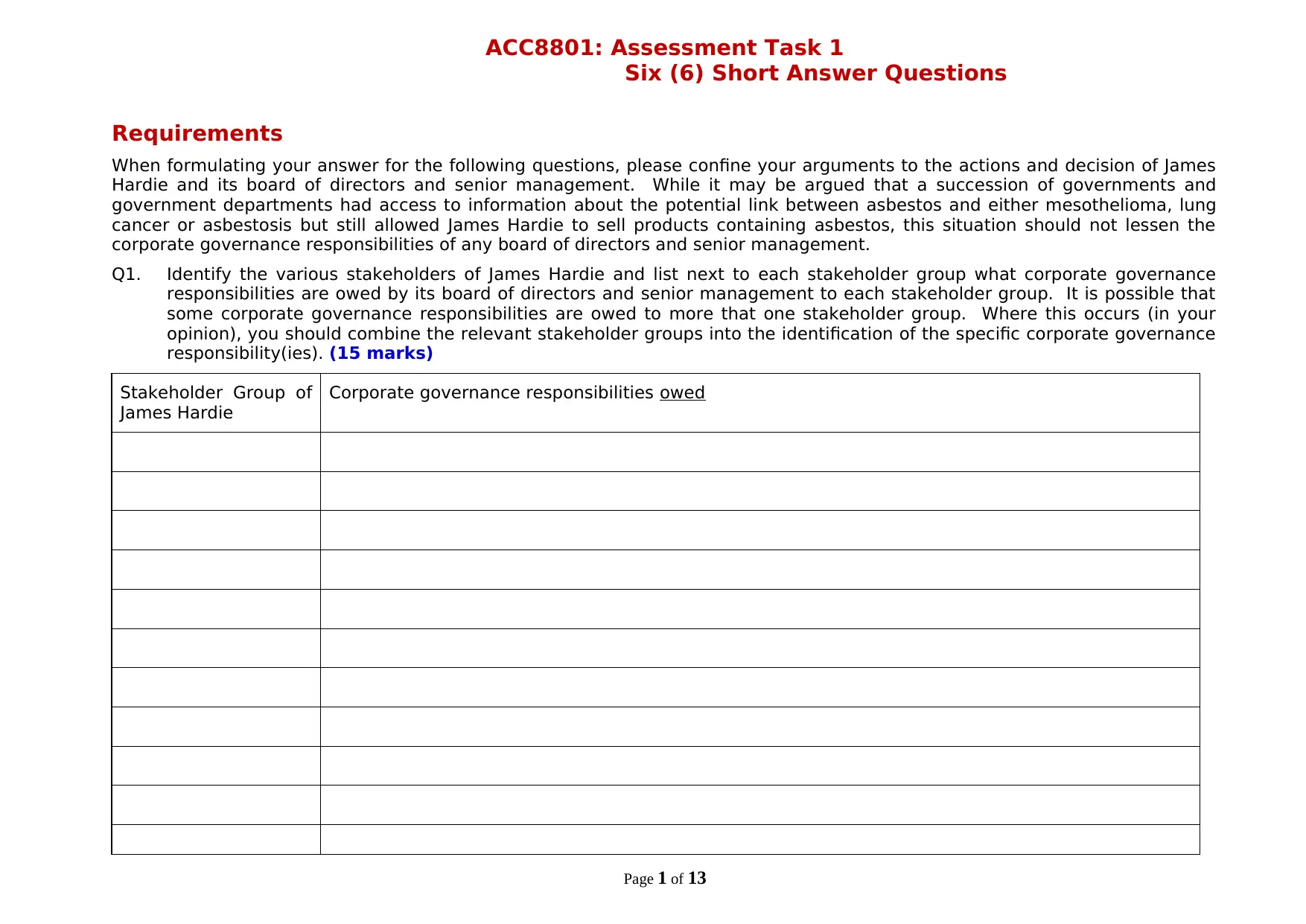
ACC8801: Assessment Task 1
Six (6) Short Answer Questions
Requirements
When formulating your answer for the following questions, please confine your arguments to the actions and decision of James
Hardie and its board of directors and senior management. While it may be argued that a succession of governments and
government departments had access to information about the potential link between asbestos and either mesothelioma, lung
cancer or asbestosis but still allowed James Hardie to sell products containing asbestos, this situation should not lessen the
corporate governance responsibilities of any board of directors and senior management.
Q1. Identify the various stakeholders of James Hardie and list next to each stakeholder group what corporate governance
responsibilities are owed by its board of directors and senior management to each stakeholder group. It is possible that
some corporate governance responsibilities are owed to more that one stakeholder group. Where this occurs (in your
opinion), you should combine the relevant stakeholder groups into the identification of the specific corporate governance
responsibility(ies). (15 marks)
Stakeholder Group of
James Hardie
Corporate governance responsibilities owed
Page 1 of 13
Six (6) Short Answer Questions
Requirements
When formulating your answer for the following questions, please confine your arguments to the actions and decision of James
Hardie and its board of directors and senior management. While it may be argued that a succession of governments and
government departments had access to information about the potential link between asbestos and either mesothelioma, lung
cancer or asbestosis but still allowed James Hardie to sell products containing asbestos, this situation should not lessen the
corporate governance responsibilities of any board of directors and senior management.
Q1. Identify the various stakeholders of James Hardie and list next to each stakeholder group what corporate governance
responsibilities are owed by its board of directors and senior management to each stakeholder group. It is possible that
some corporate governance responsibilities are owed to more that one stakeholder group. Where this occurs (in your
opinion), you should combine the relevant stakeholder groups into the identification of the specific corporate governance
responsibility(ies). (15 marks)
Stakeholder Group of
James Hardie
Corporate governance responsibilities owed
Page 1 of 13
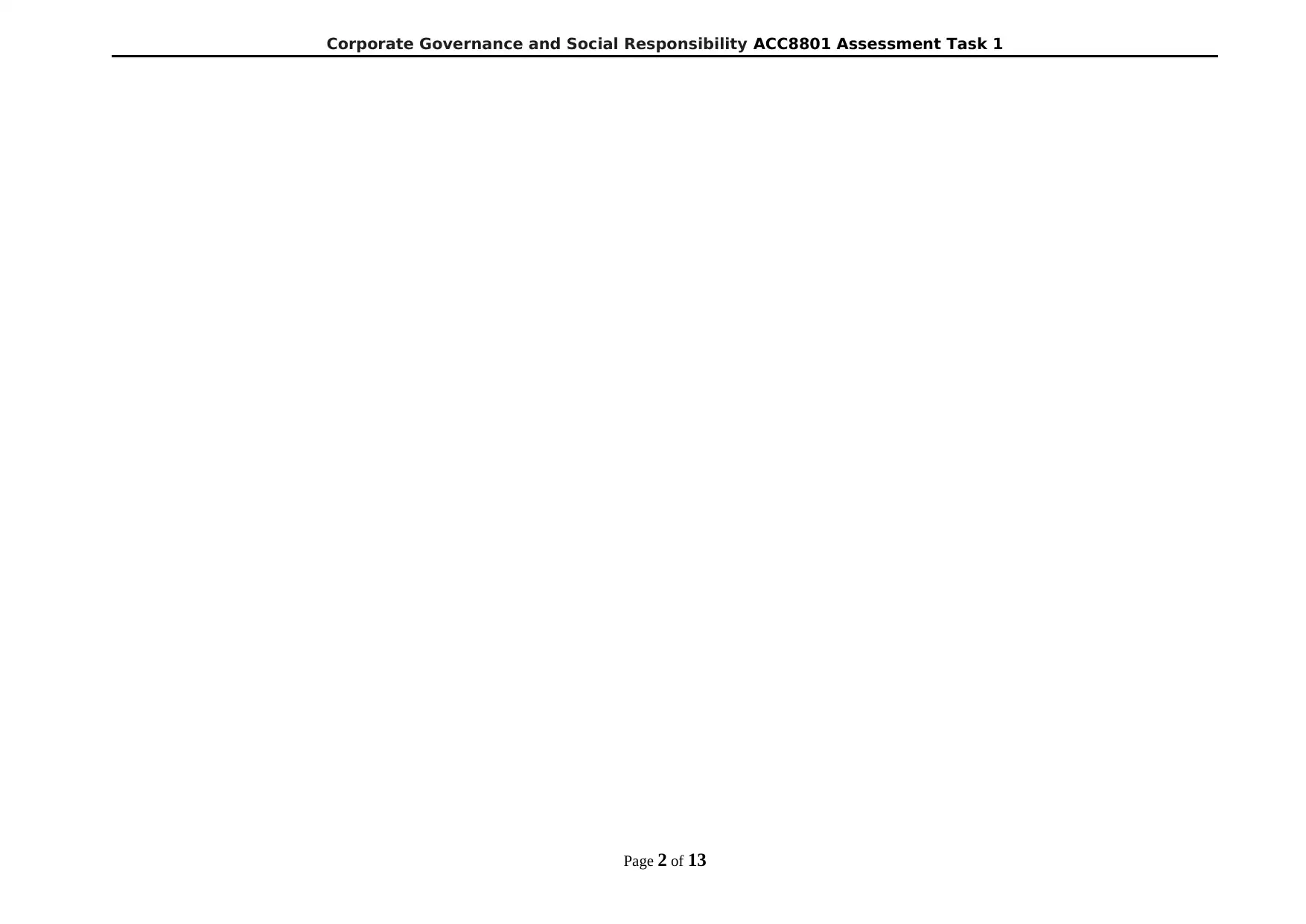
Corporate Governance and Social Responsibility ACC8801 Assessment Task 1
Page 2 of 13
Page 2 of 13
⊘ This is a preview!⊘
Do you want full access?
Subscribe today to unlock all pages.

Trusted by 1+ million students worldwide
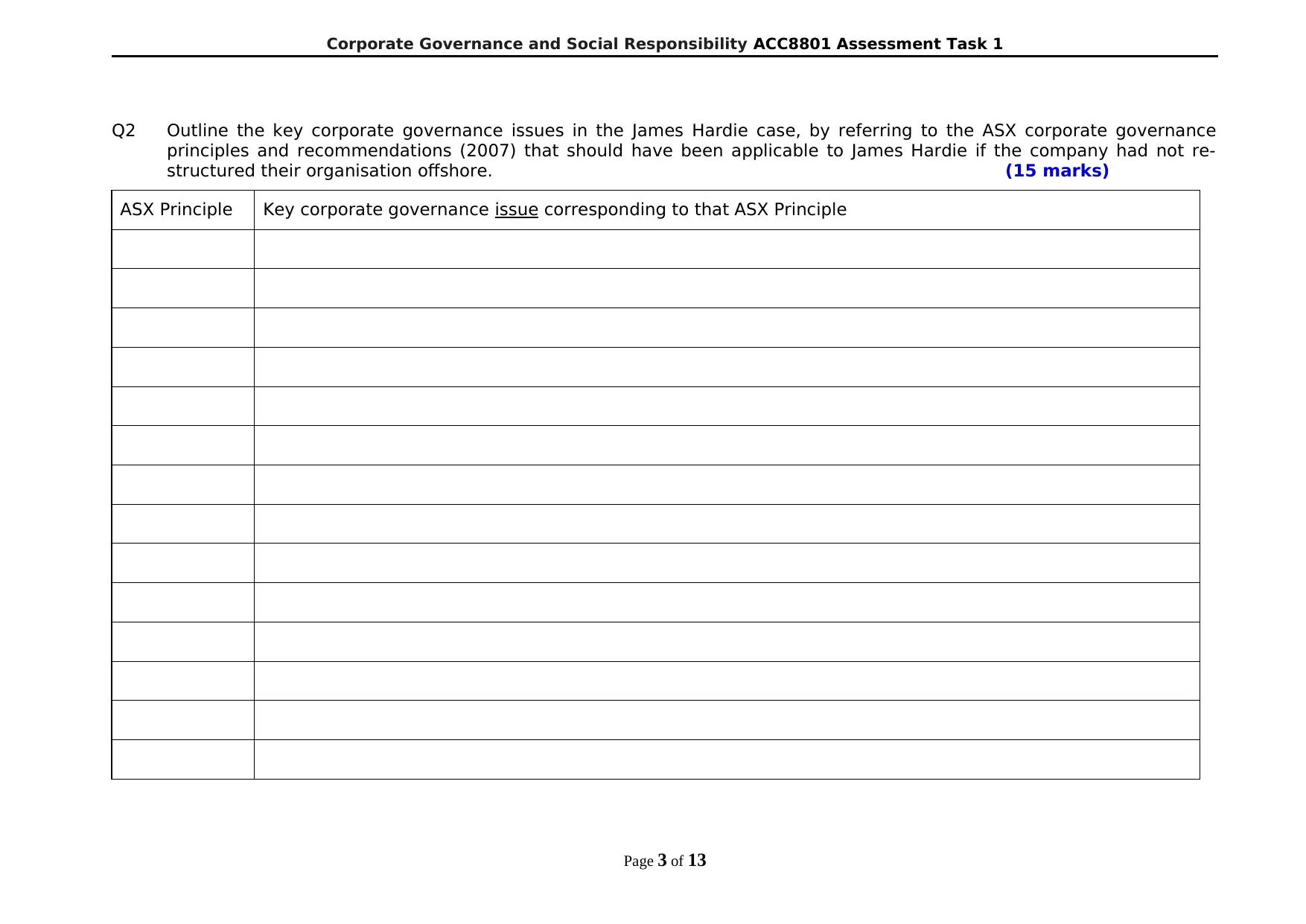
Corporate Governance and Social Responsibility ACC8801 Assessment Task 1
Q2 Outline the key corporate governance issues in the James Hardie case, by referring to the ASX corporate governance
principles and recommendations (2007) that should have been applicable to James Hardie if the company had not re-
structured their organisation offshore. (15 marks)
ASX Principle Key corporate governance issue corresponding to that ASX Principle
Page 3 of 13
Q2 Outline the key corporate governance issues in the James Hardie case, by referring to the ASX corporate governance
principles and recommendations (2007) that should have been applicable to James Hardie if the company had not re-
structured their organisation offshore. (15 marks)
ASX Principle Key corporate governance issue corresponding to that ASX Principle
Page 3 of 13
Paraphrase This Document
Need a fresh take? Get an instant paraphrase of this document with our AI Paraphraser
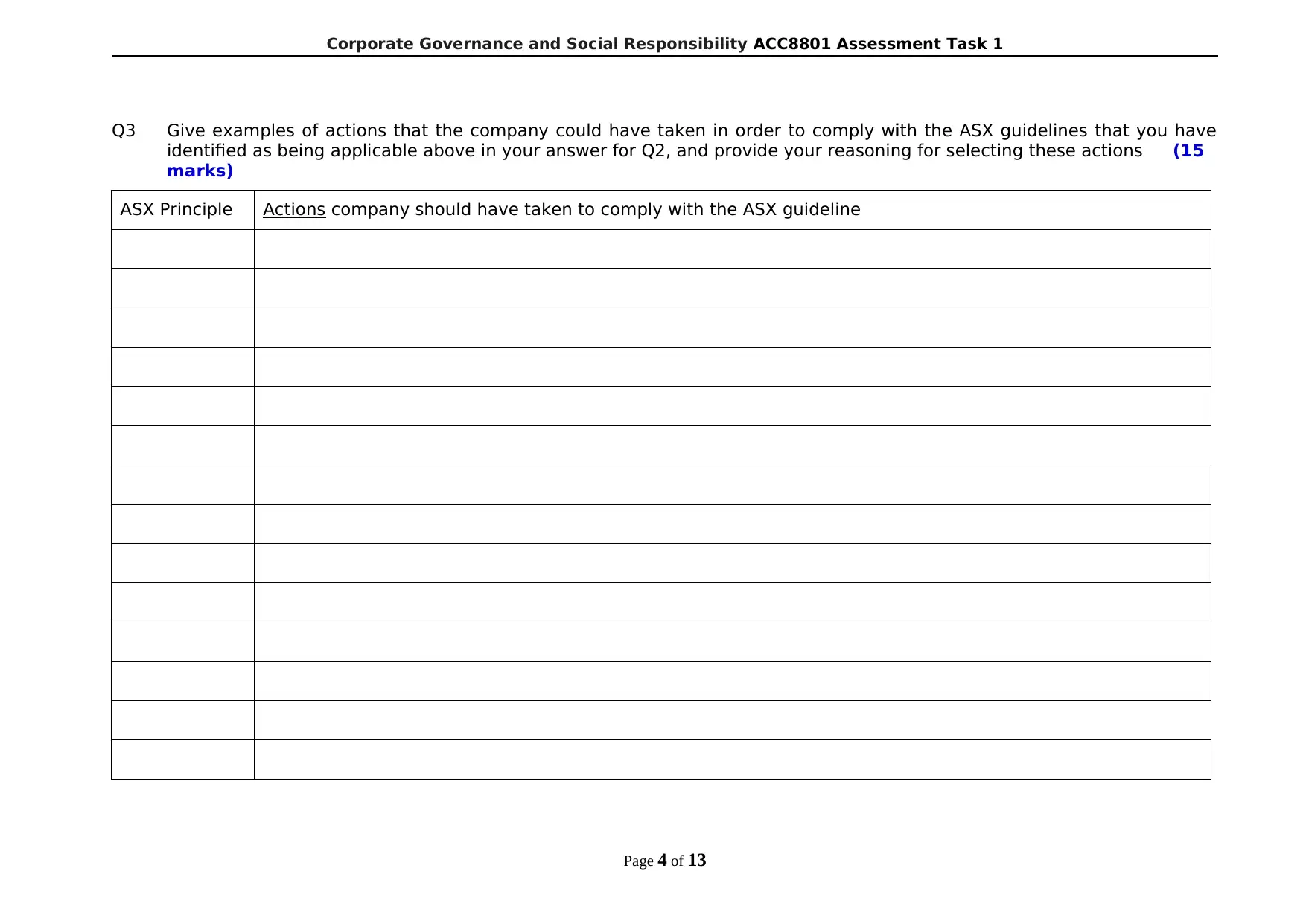
Corporate Governance and Social Responsibility ACC8801 Assessment Task 1
Q3 Give examples of actions that the company could have taken in order to comply with the ASX guidelines that you have
identified as being applicable above in your answer for Q2, and provide your reasoning for selecting these actions (15
marks)
ASX Principle Actions company should have taken to comply with the ASX guideline
Page 4 of 13
Q3 Give examples of actions that the company could have taken in order to comply with the ASX guidelines that you have
identified as being applicable above in your answer for Q2, and provide your reasoning for selecting these actions (15
marks)
ASX Principle Actions company should have taken to comply with the ASX guideline
Page 4 of 13
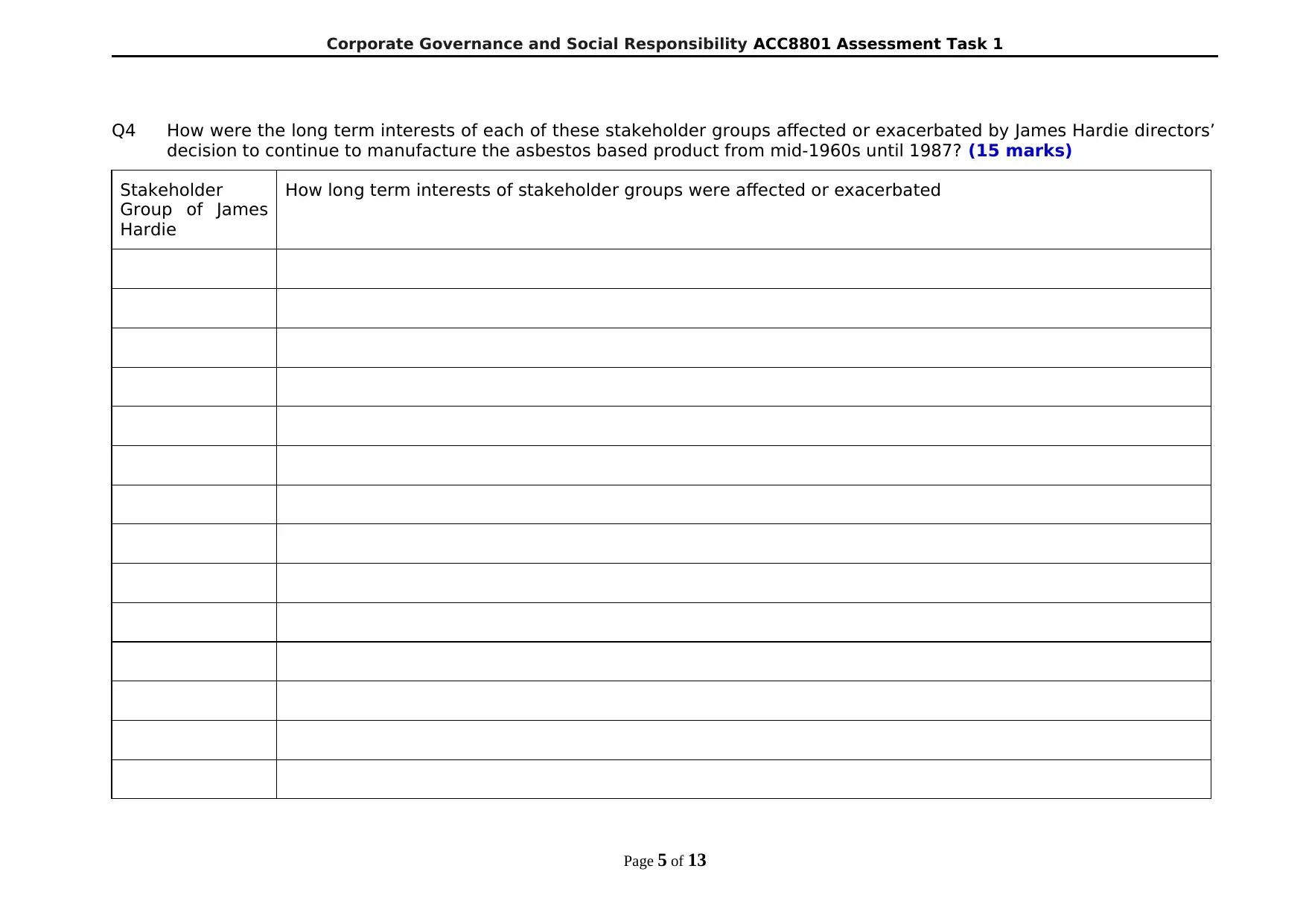
Corporate Governance and Social Responsibility ACC8801 Assessment Task 1
Q4 How were the long term interests of each of these stakeholder groups affected or exacerbated by James Hardie directors’
decision to continue to manufacture the asbestos based product from mid-1960s until 1987? (15 marks)
Stakeholder
Group of James
Hardie
How long term interests of stakeholder groups were affected or exacerbated
Page 5 of 13
Q4 How were the long term interests of each of these stakeholder groups affected or exacerbated by James Hardie directors’
decision to continue to manufacture the asbestos based product from mid-1960s until 1987? (15 marks)
Stakeholder
Group of James
Hardie
How long term interests of stakeholder groups were affected or exacerbated
Page 5 of 13
⊘ This is a preview!⊘
Do you want full access?
Subscribe today to unlock all pages.

Trusted by 1+ million students worldwide
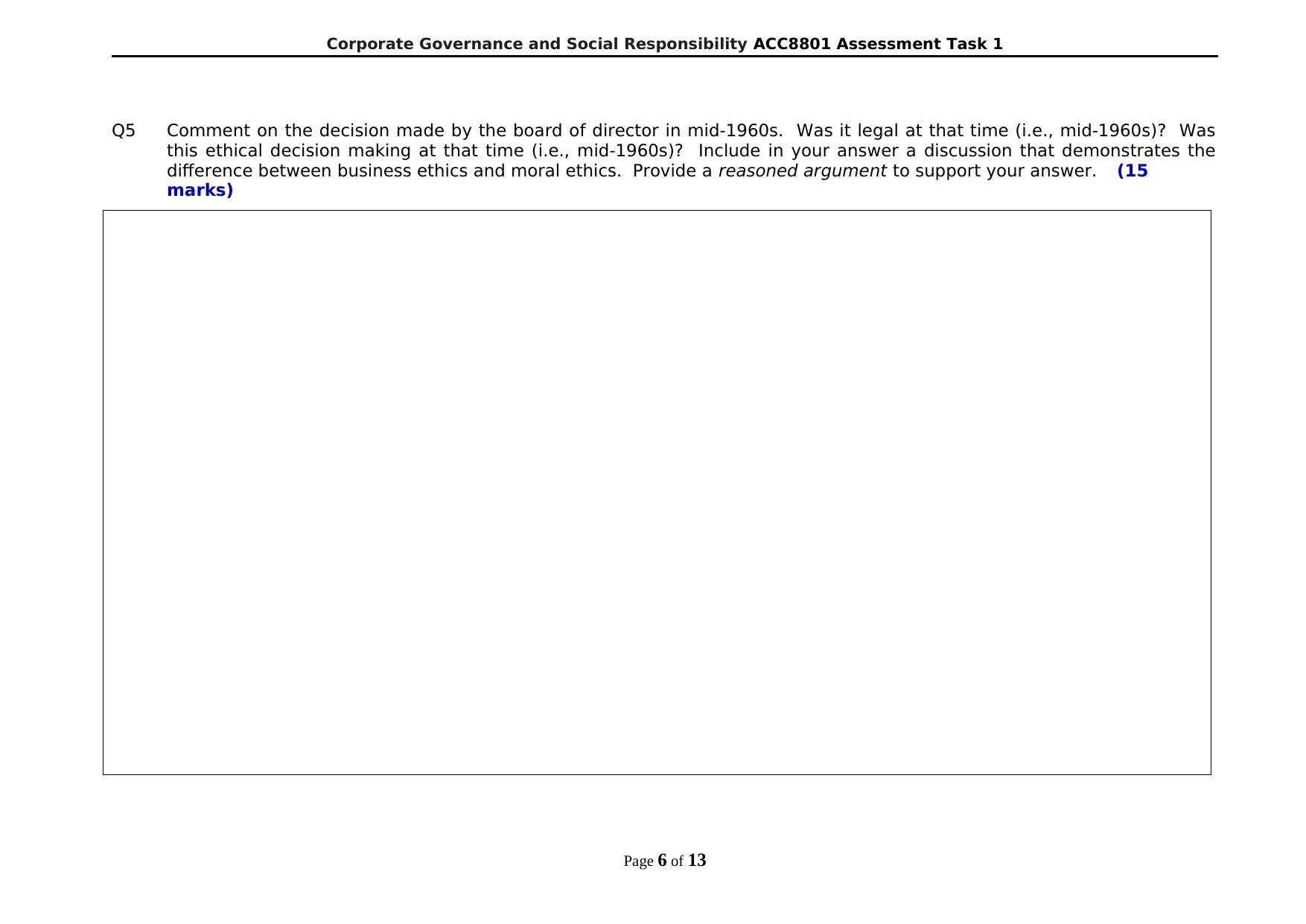
Corporate Governance and Social Responsibility ACC8801 Assessment Task 1
Q5 Comment on the decision made by the board of director in mid-1960s. Was it legal at that time (i.e., mid-1960s)? Was
this ethical decision making at that time (i.e., mid-1960s)? Include in your answer a discussion that demonstrates the
difference between business ethics and moral ethics. Provide a reasoned argument to support your answer. (15
marks)
Page 6 of 13
Q5 Comment on the decision made by the board of director in mid-1960s. Was it legal at that time (i.e., mid-1960s)? Was
this ethical decision making at that time (i.e., mid-1960s)? Include in your answer a discussion that demonstrates the
difference between business ethics and moral ethics. Provide a reasoned argument to support your answer. (15
marks)
Page 6 of 13
Paraphrase This Document
Need a fresh take? Get an instant paraphrase of this document with our AI Paraphraser
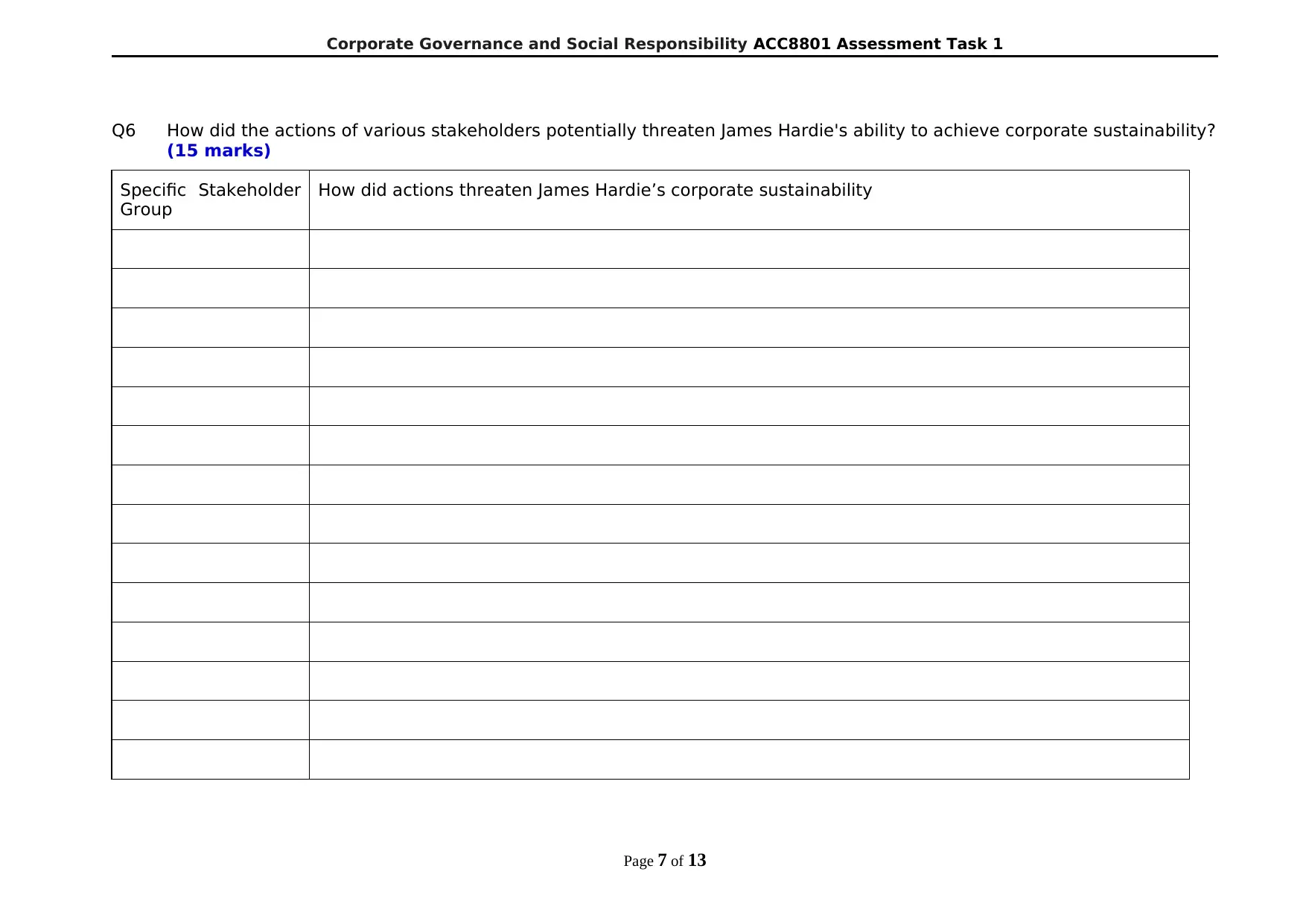
Corporate Governance and Social Responsibility ACC8801 Assessment Task 1
Q6 How did the actions of various stakeholders potentially threaten James Hardie's ability to achieve corporate sustainability?
(15 marks)
Specific Stakeholder
Group
How did actions threaten James Hardie’s corporate sustainability
Page 7 of 13
Q6 How did the actions of various stakeholders potentially threaten James Hardie's ability to achieve corporate sustainability?
(15 marks)
Specific Stakeholder
Group
How did actions threaten James Hardie’s corporate sustainability
Page 7 of 13
1 out of 11
Your All-in-One AI-Powered Toolkit for Academic Success.
+13062052269
info@desklib.com
Available 24*7 on WhatsApp / Email
![[object Object]](/_next/static/media/star-bottom.7253800d.svg)
Unlock your academic potential
Copyright © 2020–2025 A2Z Services. All Rights Reserved. Developed and managed by ZUCOL.

